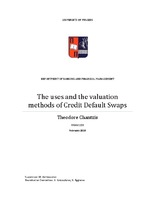The uses and the valuation methods of Credit Default Swaps

Προβολή/
Θεματική επικεφαλίδα
Πιστωτικός κίνδυνος ; Ομόλογα ; Διαχείριση κινδύνουΠερίληψη
This thesis studies Credit Derivatives and especially the nature of Credit Default Swaps (CDS) and their main characteristics. CDS attracted the attention of policy makers and market investors after the global financial crisis of 2007. In addition, during the European debt crisis, CDS became very popular, thus they offer trading for a wide range of instruments (fixed income and equity) with exposure to credit risk. The reason why it is so important that more is known about the accuracy of sovereign CDS spreads is that sovereign defaults can severely damage the global financial stability. The sovereign credit risk that is attached to a nation has a bigger impact on the financial system than macro-economic risks, market liquidity risks, and emerging market risks (IMF 2011). Furthermore, in the thesis, it is described how CDS markets work, the basic structure of CDS, the documentation, the strategies which are based on CDS contracts, like hedging, arbitrage and asset swap. We also review the literature which deals with CDS pricing, the basic determinants of CDS and factors affect the strategies and examine the relationship between CDS spread and key macroeconomic factors, especially in Portugal, Italy, Ireland, Greece and Spain (PIIGS).


